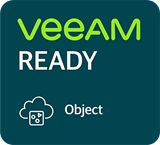Configure the Backup Repository
Veeam Backup & Replication keeps backup files, VM copies, and metadata for replicated VMs in a backup repository. You can use different types of storage as the backup repository.
To configure a backup repository from the Veeam Backup & Replication Console, select Backup Infrastructure, then Backup Repositories, and then click Add Repository. The available options that correlate to Oracle Cloud Infrastructure are Direct attached storage, Network attached storage, and Object storage.
When you create scale-out repositories, Veeam lets you choose both direct-attached storage and network-attached storage as the performance tier and object storage as the capacity tier. To read more about these tiers, see the “Veeam Scale-Out Backup Repository” section later in this document.
A full list of storage types is available in the “Backup Repository” section of the Veeam Backup & Replication User Guide, referenced referenced in the "Before You Begin" topic for more detailed information.
The following sections describe how you can use various Oracle Cloud Infrastructure storage services as a backup repository.
Configure Block Volumes as a Backup Repository
Veeam Backup & Replication lets you add a virtual server or a physical server as a backup repository. This means that you can allocate a block storage volume in Oracle Cloud Infrastructure to the Veeam server or any other server and attach the direct-attached storage as a backup repository.
Configure File Storage as a Backup Repository
Veeam Backup & Replication lets you attach an NFS or CIFS share as a backup repository. Oracle Cloud Infrastructure provides a durable, scalable, and secure network file system called Oracle Cloud Infrastructure File Storage. You can deploy a file system in Oracle Cloud Infrastructure and add it as a backup repository in Veeam Backup & Replication.
This section describes how to create a file system and add it as a backup repository.
Create Resources in File Storage
We recommend creating a separate private subnet to deploy File Storage (file systems and mount targets).
Add Network Attached Storage as the Backup Repository
Complete the following steps to add the file system as an NFS share.
- In the Veeam Backup & Replication Console, select Backup Infrastructure, select Backup Repositories, and then click Add Repository.
- In the Add Backup Repository wizard, select Network attached storage.
- Select NFS Share.
- Provide the required values in the wizard. On the Share page, specify the server and shared folder details in
server:/folderformat. - Finish the wizard to add an NFS repository.
Configure Object Storage as a Backup Repository

For additional information about Veeam Ready and OCI Object Storage, see the OCI blog post, OCI Object Storage is certified as Veeam Ready - Object, accessible from the Explore More section elsewhere in the playbook.
Note:
We recommend that you read more about Object Storage tiers and understand their capabilities, in the Oracle Cloud Infrastructure document, Overview of Object Storage.Veeam currently supports OCI Object Storage Standard and Infrequent Access tiers.
Use the S3 Compatibility API
Now use the Amazon S3 Compatibility API to access Object Storage in Oracle Cloud Infrastructure Amazon S3 Compatibility API support is provided at the bucket level and object level. Use the S3 Compatibility API in the following topics to add Object Storage as a backup repository in Veeam Backup & Replication.
mynamespace.compat.objectstorage.us-phoenix-1.oraclecloud.comNote:
To determine the region identifier and read more about other variables, see the Amazon S3 Compatibility API, accessible from the "Before You Begin" topic of this playbook.